Aardonyx Guide:
Aardonyx was an early dinosaur that lived in South Africa about 200 million years ago.
Aardonyx was an early dinosaur that lived in South Africa about 200 million years ago.
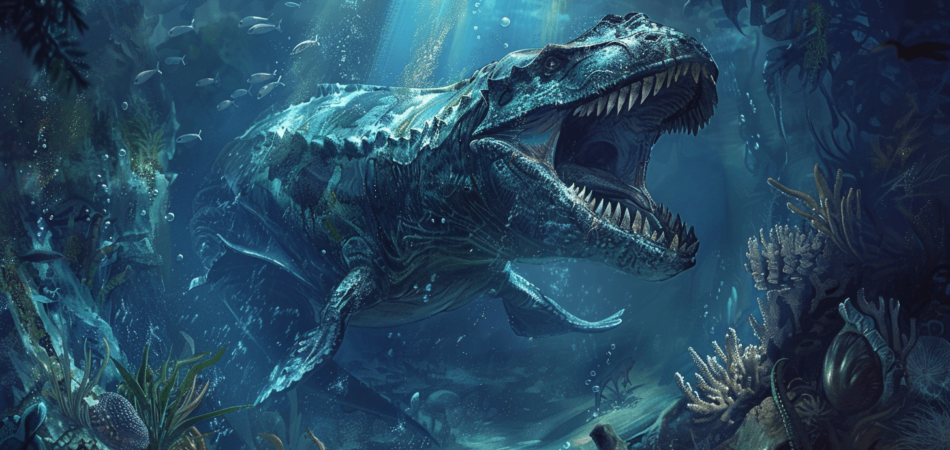
Plunging into the depths of prehistoric oceans, the Mosasaurus emerges as a titan of the ancient seas, captivating those who dare to trace its watery trails. This marine lizard, with its formidable jaws and muscular, streamlined body, reigned supreme in the Late Cretaceous period, leaving a legacy that puzzles and fascinates scientists to this day.
Its discovery reshaped our understanding of the past, painting a vivid picture of life beneath the waves millions of years ago. As we explore its evolutionary significance, physical attributes, and the ecosystems it dominated, one can’t help but wonder what secrets still lie buried, waiting to surface and expand our knowledge of these magnificent creatures.
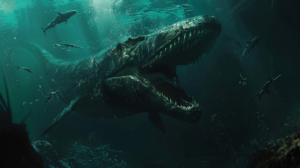
The journey of discovering Mosasaurus started with the unearthing of its fossils. This led to a fascinating tale of scientific exploration.
Initially, these remains were mistakenly identified, highlighting the challenges faced in early paleontology. This process of identification and correction has significantly contributed to our understanding of ancient marine life.
In 1764, Dutch naturalist and anatomist Petrus Camper first uncovered Mosasaurus fossils, marking the beginning of our knowledge of these massive marine predators. The discovery journey of Mosasaurus, a late Cretaceous marine reptile, reveals fascinating insights into its paleoecology, size, and the breadth of its geographic distribution.
Often, Mosasaurus fossils were mistakenly identified as belonging to a completely different group of marine lizards upon their initial discovery. This confusion stemmed from their massive size and unique features, which resembled those of both modern lizards and prehistoric marine reptiles. The classification of Mosasaurus within the Squamata order, alongside modern lizards and snakes, added layers to this misidentification. Despite these initial mix-ups, understanding of the Mosasaurus, or “Meuse lizard,” has significantly evolved.
| Term | Clarification |
|---|---|
| Misidentification | Initially thought to be a different marine lizard |
| Squamata | Order to which Mosasaurus belongs, including modern lizards |
| Lacertilia | Suborder including lizards, highlighting classification confusion |
| Massive Size | Contributed to initial confusion and awe |
This table highlights the journey from confusion to clarity in the fascinating discovery of the Mosasaurus. Researchers initially struggled to understand the significance of the Mosasaurus fossils, often mistaking them for other marine reptiles. However, as more specimens were uncovered and studied, the unique characteristics of this ancient creature began to emerge, revealing its role as a dominant predator in prehistoric seas. In a similar vein, the giganotosaurus fascinating facts and history also showcase how the discovery of another remarkable dinosaur challenged existing paradigms, enriching our understanding of the complex evolutionary web that has graced our planet.
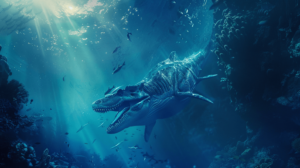
Understanding the evolutionary significance of Mosasaurus offers insights into the dynamics of marine ecosystems during the Late Cretaceous period, showcasing how this dominant predator adapted to changes in its environment. The fossil record of Mosasaurus not only illuminates the existence of this formidable marine predator but also serves as a testament to the adaptability and resilience of aquatic reptiles in the face of environmental changes. Here are key aspects that highlight the evolutionary significance of Mosasaurus:
The evolutionary significance of Mosasaurus extends beyond its role as a fearsome predator. It sheds light on the intricate interplay between marine organisms and their environments during the Cretaceous period, contributing to our understanding of ancient marine ecosystems and the forces that shape them.
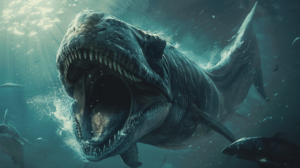
Turning our attention to the physical characteristics of Mosasaurus, it’s essential to highlight their impressive size and length. These creatures could reach up to 50 feet, making them colossal predators of the ancient oceans.
Their jaw strength was formidable, equipped with sharp teeth capable of capturing and efficiently devouring prey.
The Mosasaurus, one of the ocean’s most formidable predators, reached lengths of up to 50 feet, making it a giant among aquatic creatures. This impressive size and length weren’t just for show; they played a crucial role in its ability to dominate underwater environments.
Mosasaurus’ jaw strength, among the most formidable in the marine prehistoric world, allowed it to deliver crushing bites to its prey. Its jaws, specially adapted for gripping and tearing, made it a fearsome predator in the ocean’s depths.
This incredible bite force wasn’t just for show; it enabled the Mosasaurus to easily overpower large aquatic creatures and even demolish structures that stood in its way. The precision and efficiency of its hunting techniques underscored its status as a top-tier predator, making it a dominant force in underwater combat scenarios.
The combination of jaw strength, bite force, and the ability to grip and tear through flesh and bone with ease cemented Mosasaurus’ reputation as a master hunter of the ancient seas.
Within the diverse world of extinct creatures, a remarkable range of variability exists among Mosasaurus species, showcasing everything from striking color differences to unique physical adaptations. Each fossil specimen reveals a story of species variability that not only fascinates researchers but also offers insights into the life these ancient creatures led. The study of these fossils has illuminated the vast differences in color variations, unique characteristics, and even preferred habitats of various Mosasaurus subspecies.
To illustrate the species variability among Mosasaurus, consider the following aspects:
Rare variants with special adaptations further underscore the incredible diversity within the Mosasaurus genus. Through the study of these ancient creatures, scientists continue to uncover the unique characteristics that allowed Mosasaurus species to dominate the marine ecosystems of their time.
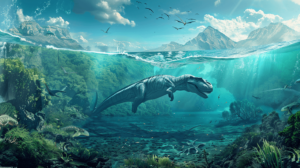
Fossil records reveal that Mosasaurus inhabited a wide range of oceanic environments, from tropical to subpolar regions, during the Late Cretaceous period. This marine animal, a dominant presence in ancient seas, found its home in diverse habitats, including the vast expanses of the western interior seaway. With a preference for deep ocean waters, Mosasaurus thrived in areas rich in underwater caves and trenches, which possibly served as hiding spots or hunting grounds for this formidable predator.
As a solitary creature, Mosasaurus’s lifestyle leaned towards the nomadic, roaming the open ocean in search of its next meal. These journeys often took them through a variety of marine settings, showcasing their adaptability and dominance in the marine food chain. The presence of Mosasaurus in such a broad range of habitats underscores its role as a versatile and powerful marine animal.
Despite their widespread distribution across ancient oceans, encountering a Mosasaurus in less typical environments, such as shallower waters near coastlines, was a rare sight. Such ventures were likely driven by the pursuit of food, indicating their willingness to explore new territories for sustenance. However, their primary habitat remained the deep and mysterious waters of the ocean biome, where they preferred the solitude and vastness of the underwater world.
Today, the legacy of Mosasaurus as a master of the ocean’s depths continues to intrigue and captivate. Their preference for underwater caves and open ocean roaming paints a picture of a creature perfectly adapted to life in the vast marine wilderness, making them a fascinating subject of study in the story of our planet’s ancient past.
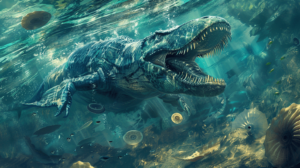
Employing a powerful conal attack, mosasaurs efficiently subdued their prey in the ancient seas. These skilled predators navigated the underwater ecosystem with a level of agility and precision that placed them at the top of the food chain. With their acute head movement and robust physical attributes, they dominated their marine environment, showcasing behaviors that ranged from high-speed chases to strategic ambushes.
The hunting behaviors of mosasaurs weren’t only aggressive but also demonstrated a remarkable adaptability to the diverse conditions of the ancient seas. Here are four key aspects that made mosasaurs formidable hunters:
These hunting behaviors underscored the mosasaur’s role as a top predator in the underwater ecosystem. Their aggressive, dynamic approach to hunting ensured their dominance over a wide range of prey, cementing their legacy as one of the ancient seas’ most formidable hunters.
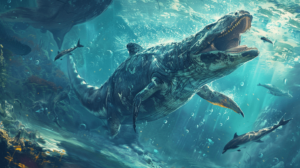
Mosasaurs faced fierce competition from other marine predators, including plesiosaurs and giant fish, as they vied for dominance in ancient oceans. These formidable creatures, known for their size and strength, had to navigate a world where survival depended on cunning, speed, and raw power. Among their rivals were the vast Leedsichthys, whose sheer size made it a formidable competitor for food resources, and the agile Plesiosaurs, which could potentially outmaneuver the slower mosasaurs in a chase for prey.
The underwater realm wasn’t just about food competition; it was also about territorial dominance. Mosasaurs, with their impressive combat prowess, often clashed with other apex predators like the fearsome Tusoteuthis and the powerful Alpha Mosas. These interactions were pivotal in establishing a hierarchy within the marine ecosystem, where only the strongest could claim control over the richest hunting grounds and secure their survival.
Understanding the dynamics of these interactions and competitions provides insight into the complex web of ancient marine life and offers valuable lessons for managing modern underwater survival strategies.